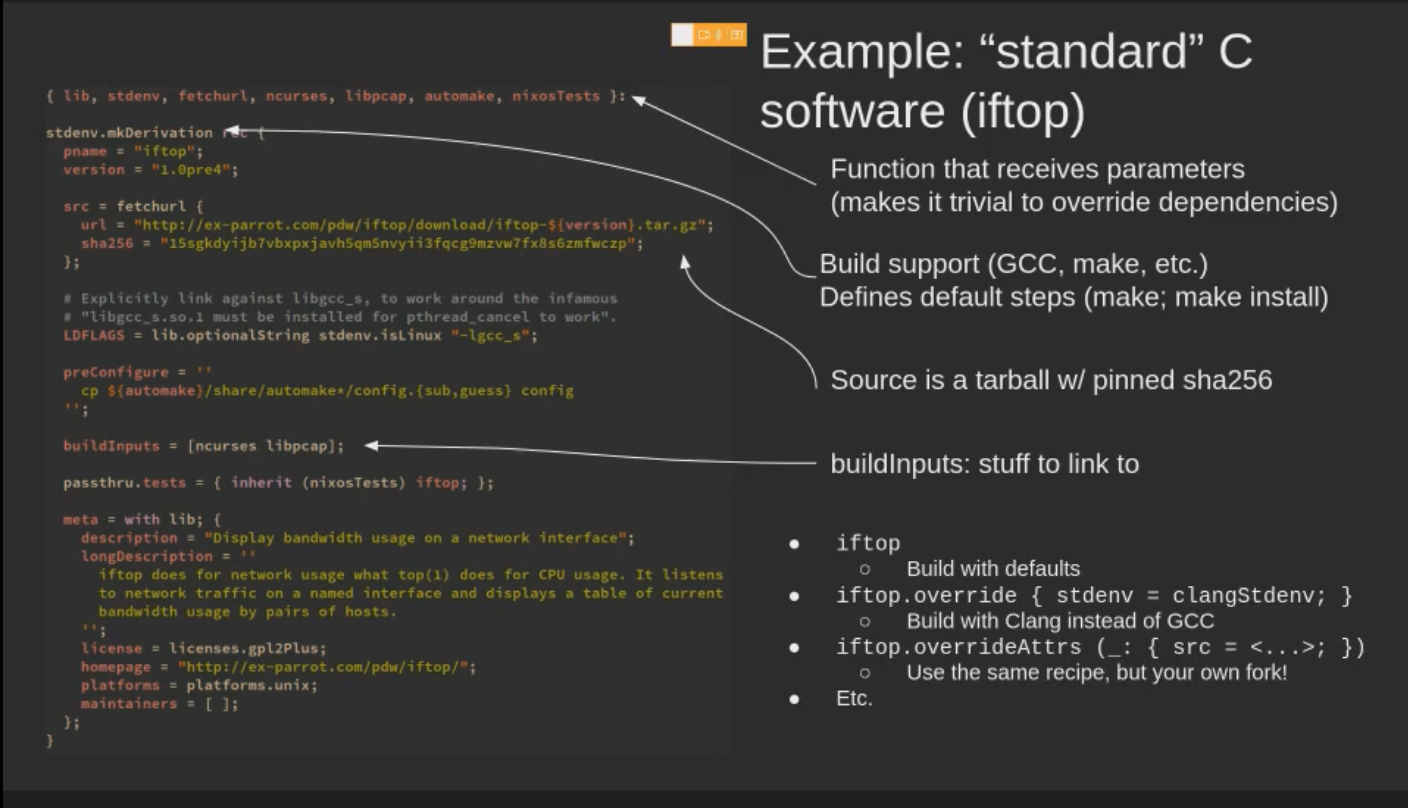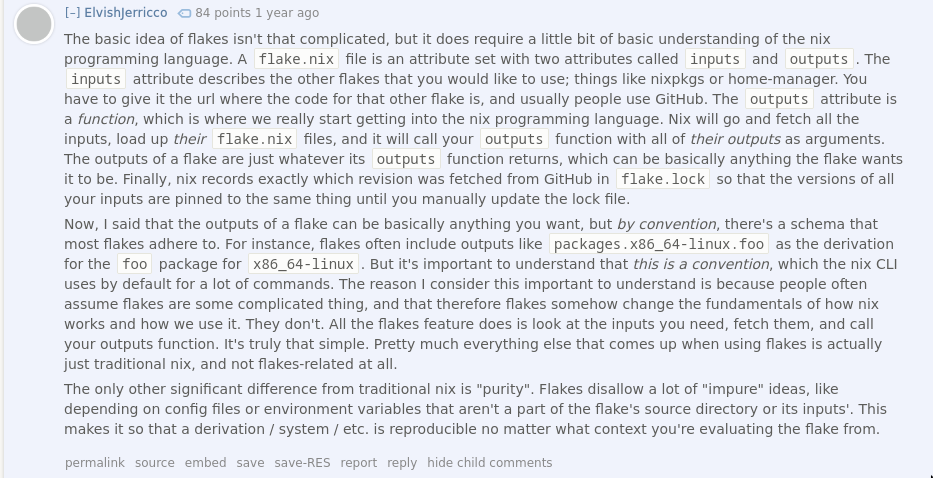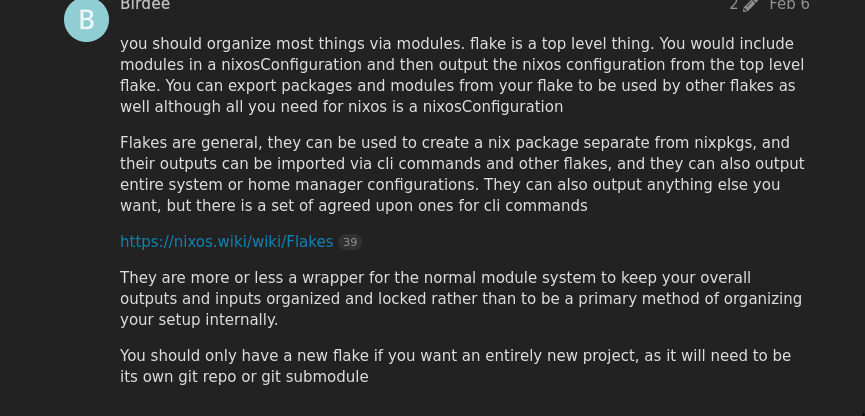tags : Linux - See Nix from the bottom up (Best explanation) - Possibly flake best explanation: Practical Nix flake anatomy: a guided tour of flake.nix | Vladimir Timofeenko’s blog - Explanation of overlays: Mastering Nixpkgs Overlays: Techniques and Best Practice - https://zaynetro.com/explainix
https://nixos-and-flakes.thiscute.world/
Building static binaries in Nix — kokada
FAQ
TODO NixOS Module vs Flake
- NixOS module is a function: output is an attribute set `imports`, `options`, and `config`.
- Flake we have inputs and outputs
Tools
Flakes?
/u/ElvishJerricco gave a explanation that finally clicked it for me.
and
Pain points
- Installing ruff via pip on NixOs does not work · Issue #1699 · astral-sh/ruff · GitHub
- Thankful for autoPatchelfHook for library dependency tweaks - Development - NixOS Discourse
NixOS
- NixOS does away with FHS with nix-store
- nix-store output = hash of recipie + package name + package version
- This allows nix-store
- to have different versions of the same software package
- to have same version but compiled with different flags aswell!
- Has some FHS stuff to keep things posix compliant, eg
/bin/sh,/usr/bin/env, all other stuff goes into/nix/storeand everything else gets symlinked from/run/current-system
Module system

Tools
nixos-option services.interception-tools.pluginsto dig down on options available- home manager options: https://mipmip.github.io/home-manager-option-search/?query=keychain
- https://lazamar.co.uk/nix-versions/
Installing NixOS
Q: With or without flakes? / channels OR flakes? flakes also seem to use channels? WHAT! A: We will choose flakes at whatever points we can. Team flakes.
Remote machines (Servers/VMs etc)
Meta
-
Options we have
Option Description Pros Cons nixinfect nixosanywhere official nixos ami Simple installation, management via something like colmena official nixos ami + user-data config at max can be 16k, on every boot it’ll build official nixos ami + customized via packerSee this and this This will prevent nixos-rebuild on every boot and make boot faster Have to store the AMI somewhere, S3? official nixos ami + customized via nixos-generator it’s packer vs doing via nixos-generator, example w flakes Official way of doing it for nixos compared to using packer custom iso nixos-generator helps generate iso/ami
-
cloud-init / user-data
- Seems
cloud-init(See LXC & LXD) is not preferred/supported in nixos - But we need user-data when launching new scripts!
- For that reason we have amazon-init but it has limitations like it doesn’t support gzip like cloud-init. So your
configuration.nixhas to be <16k for now.- The
fetch-ec2-metadataservice in NixOS fetches user data from IMDS and stores in /etc/ec2-metadata/user-data. - The
amazon-initservice inspects the downloaded user data and tries to detect a script or Nix expression. - So basically we can have nix expression as user-data in aws and things should work.
- If you’re using secrets here, can use something like sops w/ kms.
- The
- Seems
-
Managing secrets with user-data
- Secrets manager can be used, but parameter store is free so that can be used as-well, the instance just has to be started with the correct iam roles etc. Then use aws cli to pull in secrets.
- See What is the best possible way to pass API key for AWS EC2 user data script - Stack Overflow
- For something like nixos, it can be a one-off systemd unit file and script
-
Installing to a different architecture
Hetzner
-
nix-parts vs nix-utils
- vanilla: I’m a big fan of this pattern: devShells = builtins.mapAttrs (system: pkgs: { default = adsfasdf asdfsadfa asdfasdf; }) inputs.nixpkgs.legacyPackages; No framework required.
-
Installing nixos on hetzner
- way1: ssh into ubuntu and manually install nixos
- way2: hetzner cloud provides nixos iso, we can mount it and install it
- way3: nix infect
- way4: nix anywhere, example repo
- way5: nix anywhere with terraform
-
way5: nix-anywhere with terraform
- First we need to setup a fresh ubuntu server using normal hcloud tf modules
- Build on remote was not working
- So I was like fuck it, nix-everywhere and tf is out of the syllabus. I also don’t like how tf is being used to provision, i’d much prefer using nix-everywhere directly via makefile/bashscript or via ansible
- Catch is that we’re using ARM here
- Installing using the
--build-on-remoteflag worked. Butt switch had issues - So i tried doing rebuild switch
- issues: https://github.com/NixOS/nixpkgs/issues/177873
nixos-rebuild switch --flake .#hetzner-cloud-aarch64 --build-host 0x0 --target-host 0x0 --fastis taking a looong time idk why
- ERRR: Seems like issues :(
- VERDICT: I think we can use this only for install?
- I still want to be controlling the nix-rebuild for a remote machine from my local machine
-
Notes
- Seems like the book nixos-in-production is using AMI ? from: https://github.com/NixOS/nixpkgs/tree/master/nixos/modules/virtualisation
AWS
- AWS EC2
- AWS when using Auto Scaling Group (Need complete automation)
-
Custom AMI
aws ec2 modify-instance-attribute --instance-id "i-07d9ab8e3d893da34" --ena-support
NixOs and non-nixos compatibility
Gotchas
Package manager usage

nix-env
nix-envtool manages environments, profiles and their generations.nix-env -iinstalls stuff- Using this is an anti-pattern, we go back to what we had before in non nixos. One global package for everything.
nix-shell
- It only provides a bash shell, but that’s mostly all you need.
- Ephemeral
- This allows us to do shit like
nix-shell -p go1.16 -p nodejs23and thennix-shell -p go1.20 -p ruby3and it’ll just spin up those environments for us without polluting them in the global namespace.
- This allows us to do shit like
- Reusable environments
- This is nice, picks shell.nix / default.nix from current directory
- Same idea of ephemeral but now into a file and now can be re-produced anywhere
Packaging
Golang packages
- How do I use buildGoModule? Maybe I’m dumb but I can’t figure it out - Help - NixOS Discourse
- Summary: use buildGoModule and use
lib.fakeHashwhen we don’t know the hash
- Summary: use buildGoModule and use
Ref links
- An unordered list of hidden gems inside NixOS | Lobsters
- 2. Run a program with Nix (zero 2 nix)
- Nix revisited - Charlotte’s notes
- Introduction to Nix & NixOS | NixOS & Flakes Book (Book)
- Erase your darlings: immutable infrastructure for mutable systems
- Packaging/Quirks and Caveats - NixOS Wiki
- Nix By Example | <fun>
- Nix shell template | Lobsters
- Packaging/Binaries - NixOS Wiki
- Jonathan Lorimer
- Understanding Nix Inputs #nix · GitHub
- https://github.com/nix-community/disko
- https://galowicz.de/2023/04/05/single-command-server-bootstrap/
- Setup
- Flakes
- Devops
Nix in Infra and Devops
Resources
- A Comprehensive Guide to End-to-End-Declarative Deployment with Terraform and Nix (NixOS and Terraform)
- Some notes on NixOS | Lobsters
- A faster dockerTools.buildImage prototype ·
- Self-hosting Mastodon on NixOS, a proof-of-concept
- Grafana + Prometheus + Grafana Loki with Nixops example
- Managing infrastructure with Terraform, CDKTF, and NixOS
Libraries/Tools
- nix-community/nixos-generators
- Mic92/sops-nix
- GitHub - DBCDK/morph: NixOS deployment tool
- NixOS/nixops
- nix-community/vulnix
Testing
TODO NixOS, Flakes and Home-manager for laptop
Want to do it proper this time around, will need a day or two.
- https://github.com/maralorn/nix-output-monitor
- https://github.com/yelite/lite-system/blob/main/flake-module.nix
- https://github.com/fufexan/dotfiles/tree/main
- https://www.reddit.com/r/NixOS/comments/11zm210/splitting_nix_flake_into_modules/
- https://www.reddit.com/r/NixOS/comments/10jikmp/looking_for_a_nixos_tutorial_starting_with_home/
- https://www.reddit.com/r/NixOS/comments/v2xpjm/big_list_of_flakes_tutorials/
- https://tonyfinn.com/blog/nix-from-first-principles-flake-edition/
- https://www.youtube.com/watch?v=AGVXJ-TIv3Y
- This very nice
Flake
Nix & WebAssembly
Combinations
Nix and Nvidia
https://github.com/NixOS/nixpkgs/issues/254614 https://nixos.wiki/wiki/Nvidia (nixos specialization kde/sway)
Nix and Playwright
Which playeight to go with?
- According to this thread, playwright-node is more feature-full than playwright-python.
- I personally would prefer to use the node version because eitheway you’d need to interfact with the page and you’ll need js for that reason etc.
nixpkgs playwright vs npm install & browser
- Two things
- Installing
playwright - Installing
playwright browsers
- Installing
- Installing
playwright- Both cases would work, installing
playwrightfrom nixpkgs, which installs the python version of playwright. i.eplaywright-pythoninstead ofplayroght-node - If you want
playwright-nodeyou can install using npm just like you’d install any other package. But only thing you need to make sure is to NOT install the browsers though this npm installed version of playwright.- i.e
playwright installwon’t work
- i.e
- Both cases would work, installing
- Installing
playwright browsers- If you try to install the browsers using the
playwrightcli installed using npm, it’ll not work because playwright doesn’t know how to install things in nixos. - So you install
playwright-browserfrom nixpkgs
- If you try to install the browsers using the
- Final working setup for me
- Install browsers via
playwirght-browsernixpkgs - Make sure it’s the same version that i’ve installed via npm for the playwright npm package. (Here I installed the node variant of playwright)
- Everything works now.
- Additionally I’ve to figure out Typescript setup for playwright now.
- Install browsers via
Windows x NixOS
{config, pkgs, ... }: {
programs.dconf.enable = true;
users.users.gcis.extraGroups = [ "libvirtd" ];
environment.systemPackages = with pkgs; [ virt-manager virt-viewer spice spice-gtk spice-protocol win-virtio win-spice gnome.adwaita-icon-theme ];
services.spice-vdagentd.enable = true;
virtualisation = {
libvirtd = {
enable = true;
qemu = { swtpm.enable = true; ovmf.enable = true; ovmf.packages = [ pkgs.OVMFFull.fd ]; };
};
spiceUSBRedirection.enable = true;
};
}{ pkgs, username, ... }:
{
virtualisation = {
libvirtd = {
enable = true;
qemu = {
package = pkgs.qemu_kvm;
swtpm.enable = true;
ovmf.enable = true;
ovmf.packages = [ pkgs.OVMFFull.fd ];
};
};
spiceUSBRedirection.enable = true;
};
users.users.${username}.extraGroups = [ "libvirtd" ];
environment.systemPackages = with pkgs; [
spice
spice-gtk
spice-protocol
virt-viewer
#virtio-win
#win-spice
];
programs.virt-manager.enable = true;
home-manager.users.${username} = {
dconf.settings = {
"org/virt-manager/virt-manager/connections" = {
autoconnect = [ "qemu:///system" ];
uris = [ "qemu:///system" ];
};
};
};
}Virtualization resources
- See Virtualization
- https://www.reddit.com/r/VFIO/wiki/index
- https://www.reddit.com/r/VFIO/comments/12nfck3/what_is_vfio/
- https://www.reddit.com/r/NixOS/comments/177wcyi/best_way_to_run_a_vm_on_nixos/
- https://nixos.mayflower.consulting/blog/2020/06/17/windows-vm-performance/
- https://www.google.com/search?q=nix+windows+vifo+quemu&sca_upv=1
- https://www.reddit.com/r/kvm/comments/xuvdm4/virtio_with_opengl_video_is_slower_than_qxl_on/
- https://discourse.nixos.org/t/nix-on-windows/1113
- https://github.com/quickemu-project/quickemu?tab=readme-ov-file
- https://astrid.tech/2022/09/22/0/nixos-gpu-vfio/

